A Task Scheduling Optimization Method for Vehicles Serving as Obstacles in Mobile Edge Computing Based IoV Systems
Abstract
:1. Introduction
2. Related Work
3. Corresponding Models and Problem Formulation
3.1. Model of Dynamic Dense Traffic Flow
3.2. System Architecture
3.3. Execution Time Model
3.3.1. Competition Delay
3.3.2. Processing Time
3.3.3. Calculating Cost Model
3.4. Reliability Model
3.5. Optimization Target Model
4. Solutions
4.1. Preliminary Statement
4.2. GA Solution
4.2.1. Chromosome Coding
4.2.2. Initialization of Population
4.2.3. Fitness Function
4.2.4. Genetic Operators
- Crossover Operator
- b.
- Selection Operator
- c.
- Mutation Operator
| Algorithm 1 Execution time and calculating cost of the jth workflow application |
| Input: Output: , 1. , ; 2. for j = 1 to u do 3. Calculate execution time according to Equation (24); 4. Calculate calculating cost according to Equation (29); 5. end for 6. return , |
| Algorithm 2 GA Method |
| Input: Output: 1: Initialize the gene value of the first-generation population; 2: While do 3: for to e 4: ; 5: Calculate F(); 6: = Roulette (); 7: if 8: = 9: Intersect (), Mutate () 10: else 11: = Roulette () 12: end 13: end for 14: , 15: end while 16: 17: end for 18: return |
4.3. TSARC Solution
4.3.1. Structure of TSARC
4.3.2. Main Steps of TSARC
- Coding and Initialization
- b.
- Quick Non-Dominated Sorting
- c.
- Adaptive Normalization of Population Members
- d.
- Associate Individuals and Reference Points
- e.
- Selection of Reference Point and Next Generation Population
- If is true and there is an individual related to this reference vector in the frontal surface , the point with the smallest distance should be found and extracted. Then, it should be added to the next generation individuals, and is set.
- If there is no individual associated with the reference points in the frontal surface , the reference vector should be deleted. If satisfies, its nearest reference point should be selected and the process of cycling is kept until the population size reaches N.
4.3.3. Pseudocode of TSARC
| Algorithm 3 Selection of next generation population |
| Input: Previous generation population, Output: Next generation population, 1. Non-dominated layer = Non-dominated sorting (); 2.; 3. if 4. Normalization based on Equations (35)–(37); 5. Obtain the super connector based on the reference vector in Figure 4; 6. ; 7. ; 8. else 9. ; 10. end for 11. return |
| Algorithm 4 TSARC Method |
| Input: The size N of population , all workflow applications Output: 1: Initialize the gene value of the first-generation population; 2: ; 3: while do 4: to e 5: Intersect (), Mutate (); 6: ; 7: end for 8: The next generation population ; 9: , ; 10: end while 11: ; 12: |
5. Numerical Results
5.1. Simulation Settings
5.2. Result Analysis
5.2.1. Comparison of Execution Time
5.2.2. Comparison of Calculating Cost
5.2.3. Analysis of the Influence of Traffic Flow Densities
5.2.4. Analysis of the Influence of Balance Coefficients
5.2.5. Comparison of Solving Efficiency of the Three Methods
6. Conclusions
Author Contributions
Funding
Conflicts of Interest
References
- Mu, L.T.; Ge, B.; Xia, C.X.; Wu, C. Multi-Task Offloading Based on Optimal Stopping Theory in Edge Computing Empowered Internet of Vehicles. Entropy 2022, 24, 814. [Google Scholar] [CrossRef] [PubMed]
- Hou, Y.Z.; Wang, C.R.; Zhu, M.; Xu, X.D.; Tao, X.F.; Wu, X.C. Joint Allocation of Wireless Resource and Computing Capability in MEC-Enabled Vehicular Network. China Commun. 2021, 18, 64–76. [Google Scholar] [CrossRef]
- Hoque, M.A.; Rios-Torres, J.; Arvin, R.; Khattak, A.; Ahmed, S. The extent of reliability for vehicle-to-vehicle communication in safety critical applications: An experimental study. J. Intell. Transp. Syst. 2020, 24, 264–278. [Google Scholar] [CrossRef]
- Selvakumari, P.; Sheela, D.; Chinnasamy, A. Chew’s Second Delaunay Triangulation Refinement Scheme for Optimal RSUs Deployment to Ensure Maximum Connectivity in Vehicle to Infrastructure Communication. Wirel. Pers. Commun. 2022, 123, 375–405. [Google Scholar] [CrossRef]
- Pang, S.C.; Wang, N.L.; Wang, M.; Qiao, S.B.; Zhai, X.; Xiong, N.N. A Smart Network Resource Management System for High Mobility Edge Computing in 5G Internet of Vehicles. IEEE Trans. Netw. Sci. Eng. 2021, 8, 3179–3191. [Google Scholar] [CrossRef]
- He, X.X.; Lv, J.; Zhao, J.Q.; Hou, X.L.; Luo, T. Design and Analysis of a Short-Term Sensing-Based Resource Selection Scheme for C-V2X Networks. IEEE Internet Things J. 2020, 7, 11209–11222. [Google Scholar] [CrossRef]
- Imene, L.; Sihem, S.; Okba, K.; Mohamed, B. A third generation genetic algorithm NSGAIII for task scheduling in cloud computing. J. King Saud Univ.-Comput. Inf. Sci. 2022, 34, 7515–7529. [Google Scholar] [CrossRef]
- Naghsh, Z.; Valaee, S. Conflict-Free Scheduling in Cellular V2X Communications. IEEE-ACM Trans. Netw. 2021, 29, 106–119. [Google Scholar] [CrossRef]
- Fu, F.; Kang, Y.P.; Zhang, Z.C.; Yu, F.R.; Wu, T. Soft Actor-Critic DRL for Live Transcoding and Streaming in Vehicular Fog-Computing-Enabled IoV. IEEE Internet Things J. 2021, 8, 1308–1321. [Google Scholar] [CrossRef]
- Xiao, G.B.; Zhang, H.B.; Sun, N.; Zhang, Y. Cooperative link scheduling for RSU-assisted dissemination of basic safety messages. Wirel. Netw. 2021, 27, 1335–1351. [Google Scholar] [CrossRef]
- Zhu, H.; Tao, S.; Gui, Y.; Cai, Q. Research on an Adaptive Real-Time Scheduling Method of Dynamic Job-Shop Based on Reinforcement Learning. Machines 2022, 10, 1078. [Google Scholar] [CrossRef]
- Feng, M.W.; Yao, H.Q.; Ungurean, I. A Roadside Unit Deployment Optimization Algorithm for Vehicles Serving as Obstacles. Mathematics 2022, 10, 3282. [Google Scholar] [CrossRef]
- Keshari, N.; Singh, D.; Maurya, A.K. A survey on Vehicular Fog Computing: Current state-of-the-art and future directions. Veh. Commun. 2022, 38, 100512. [Google Scholar] [CrossRef]
- Kang, B.; Yang, J.; Paek, J.; Bahk, S. ATOMIC: Adaptive Transmission Power and Message Interval Control for C-V2X Mode 4. IEEE Access 2021, 9, 12309–12321. [Google Scholar] [CrossRef]
- Mishra, D.; Trotta, A.; Traversi, E.; Di Felice, M.; Natalizio, E. Cooperative Cellular UAV-to-Everything (C-U2X) communication based on 5G sidelink for UAV swarms. Comput. Commun. 2022, 192, 173–184. [Google Scholar] [CrossRef]
- Sempere-Garcia, D.; Sepulcre, M.; Gozalvez, J. LTE-V2X Mode 3 scheduling based on adaptive spatial reuse of radio resources. Ad Hoc Netw. 2021, 113, 102351. [Google Scholar] [CrossRef]
- Kim, H.K.; Becerra, R.; Bolufe, S.; Azurdia-Meza, C.A.; Montejo-Sanchez, S.; Zabala-Blanco, D. Neuroevolution-Based Adaptive Antenna Array Beamforming Scheme to Improve the V2V Communication Performance at Intersections. Sensors 2021, 21, 2956. [Google Scholar] [CrossRef]
- Selvakumari, P.; Lakshmi, S.R.; Sheela, D.; Chinnasamy, A. Chew’s first Delaunay triangulation refinement scheme-based positioning of road side units for optimal network coverage in vehicular ad-hoc networks. Int. J. Commun. Syst. 2022, 35, e5299. [Google Scholar] [CrossRef]
- Turner, J.S.C.; Shahriman, A.B.; Harun, A.; Hashim, M.S.M.; Razlan, Z.M.; Ndzi, D.L.; Ismail, R.C.; Murad, S.A.Z.; Isa, M.N.M.; Mohyar, S.N.; et al. Signal Propagation Modelling for Vehicle-To-Infrastructure Communication Under the Influence of Metal Obstruction. Int. J. Nanoelectron. Mater. 2021, 14, 127–139. [Google Scholar]
- Boban, M.; Dupleich, D.; Iqbal, N.; Luo, J.; Schneider, C.; Muller, R.; Yu, Z.M.; Steer, D.; Jamsa, T.; Li, J.; et al. Multi-Band Vehicle-to-Vehicle Channel Characterization in the Presence of Vehicle Blockage. IEEE Access 2019, 7, 9724–9735. [Google Scholar] [CrossRef]
- Koivumaki, P.; Molisch, A.F.; Haneda, K. Line-of-Sight Probability in Cluttered Urban Microcells: Analyses Using Poisson Point Process and Point Cloud. IEEE Trans. Antennas Propag. 2022, 70, 2161–2173. [Google Scholar] [CrossRef]
- Hmamouche, Y.; Benjillali, M.; Saoudi, S. Fresnel Line-of-Sight Probability With Applications in Airborne Platform-Assisted Communications. IEEE Trans. Veh. Technol. 2022, 71, 5060–5072. [Google Scholar] [CrossRef]
- Braga, A.D.; Da Cruz, H.A.O.; Eras, L.E.C.; Araujo, J.P.L.; Neto, M.C.A.; Silva, D.K.N.; Cavalcante, G.P.S. Radio Propagation Models Based on Machine Learning Using Geometric Parameters for a Mixed City-River Path. IEEE Access 2020, 8, 146395–146407. [Google Scholar] [CrossRef]
- Lopez-Benitez, M.; Zhang, J.Y. Comments and Corrections to “New Results on the Fluctuating Two-Ray Model With Arbitrary Fading Parameters and Its Applications”. IEEE Trans. Veh. Technol. 2021, 70, 1938–1940. [Google Scholar] [CrossRef]
- Kizhakkekundil, S.; Morais, J.; Braam, S.; Litjens, R. Four Knife-Edge Diffraction With Antenna Gain Model for Generic Blockage Modelling. IEEE Wirel. Commun. Lett. 2021, 10, 2106–2109. [Google Scholar] [CrossRef]
- Kousaridas, A.; Manjunath, R.P.; Perdomo, J.; Zhou, C.; Zielinski, E.; Schmitz, S.; Pfadler, A. QoS Prediction for 5G Connected and Automated Driving. IEEE Commun. Mag. 2021, 59, 58–64. [Google Scholar] [CrossRef]
- Moltafet, M.; Leinonen, M.; Codreanu, M. Worst Case Age of Information in Wireless Sensor Networks: A Multi-Access Channel. IEEE Wirel. Commun. Lett. 2020, 9, 321–325. [Google Scholar] [CrossRef] [Green Version]
- Xu, X.L.; Liu, Q.X.; Luo, Y.; Peng, K.; Zhang, X.Y.; Meng, S.M.; Qi, L.Y. A computation offloading method over big data for IoT-enabled cloud-edge computing. Future Gener. Comput. Syst.-Int. J. Escience 2019, 95, 522–533. [Google Scholar] [CrossRef]
- Qi, W.; Sun, H.; Yu, L.C.; Xiao, S.; Jiang, H.F. Task Offloading Strategy Based on Mobile Edge Computing in UAV Network. Entropy 2022, 24, 736. [Google Scholar] [CrossRef]
- Deng, T.T.; Wei, S.L.; Liu, X.X.; Zhou, H.; Dong, M.X. Distributed Resource Allocation Based on Timeslot Reservation in High-Density VANETs. IEEE Trans. Veh. Technol. 2022, 71, 6586–6595. [Google Scholar] [CrossRef]
- Pradhan, R.; Satapathy, S.C. Energy Aware Genetic Algorithm for Independent Task Scheduling in Heterogeneous Multi-Cloud Environment. J. Sci. Ind. Res. 2022, 81, 776–784. [Google Scholar]
- Nguyen, B.M.; Binh, H.T.T.; Anh, T.T.; Son, D.B. Evolutionary Algorithms to Optimize Task Scheduling Problem for the IoT Based Bag-of-Tasks Application in Cloud-Fog Computing Environment. Appl. Sci. 2019, 9, 1730. [Google Scholar] [CrossRef]
- Zhang, H.J.; Wang, G.G. Improved NSGA-III using transfer learning and centroid distance for dynamic multi-objective optimization. Complex Intell. Syst. 2021. [Google Scholar] [CrossRef]
- Wang, L.; Wang, W. Hyperspectral Image Reconstruction Based on Reference Point Nondominated Sorting Genetic Algorithm. Mob. Inf. Syst. 2022, 2022, 8455150. [Google Scholar] [CrossRef]
- Road Traffic Statistics. Available online: https://roadtraffic.dft.gov.uk/downloads (accessed on 20 November 2022).
- Maglogiannis, V.; Naudts, D.; Hadiwardoyo, S.; van den Akker, D.; Marquez-Barja, J.; Moerman, I. Experimental V2X Evaluation for C-V2X and ITS-G5 Technologies in a Real-Life Highway Environment. IEEE Trans. Netw. Serv. Manag. 2022, 19, 1521–1538. [Google Scholar] [CrossRef]
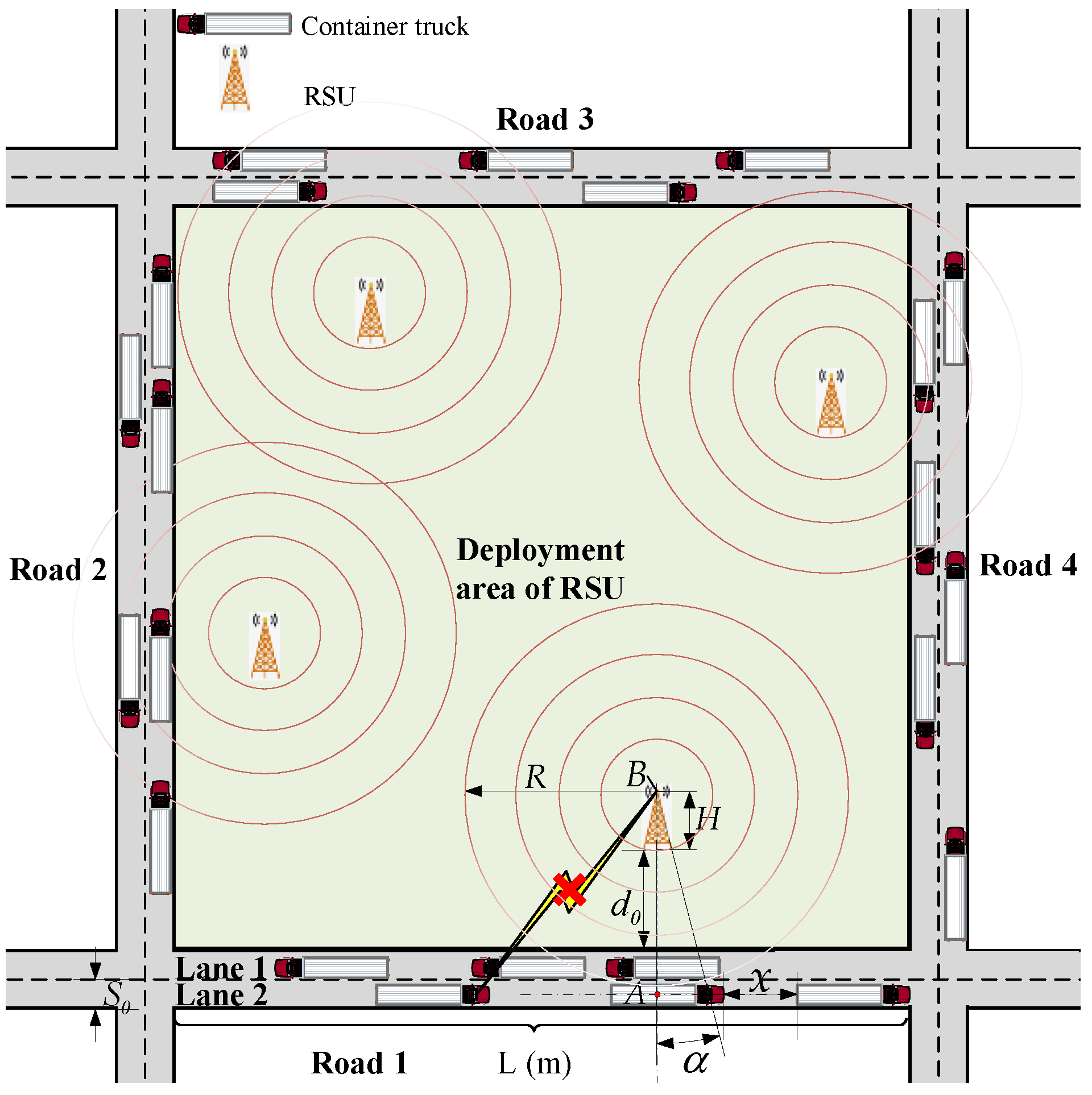

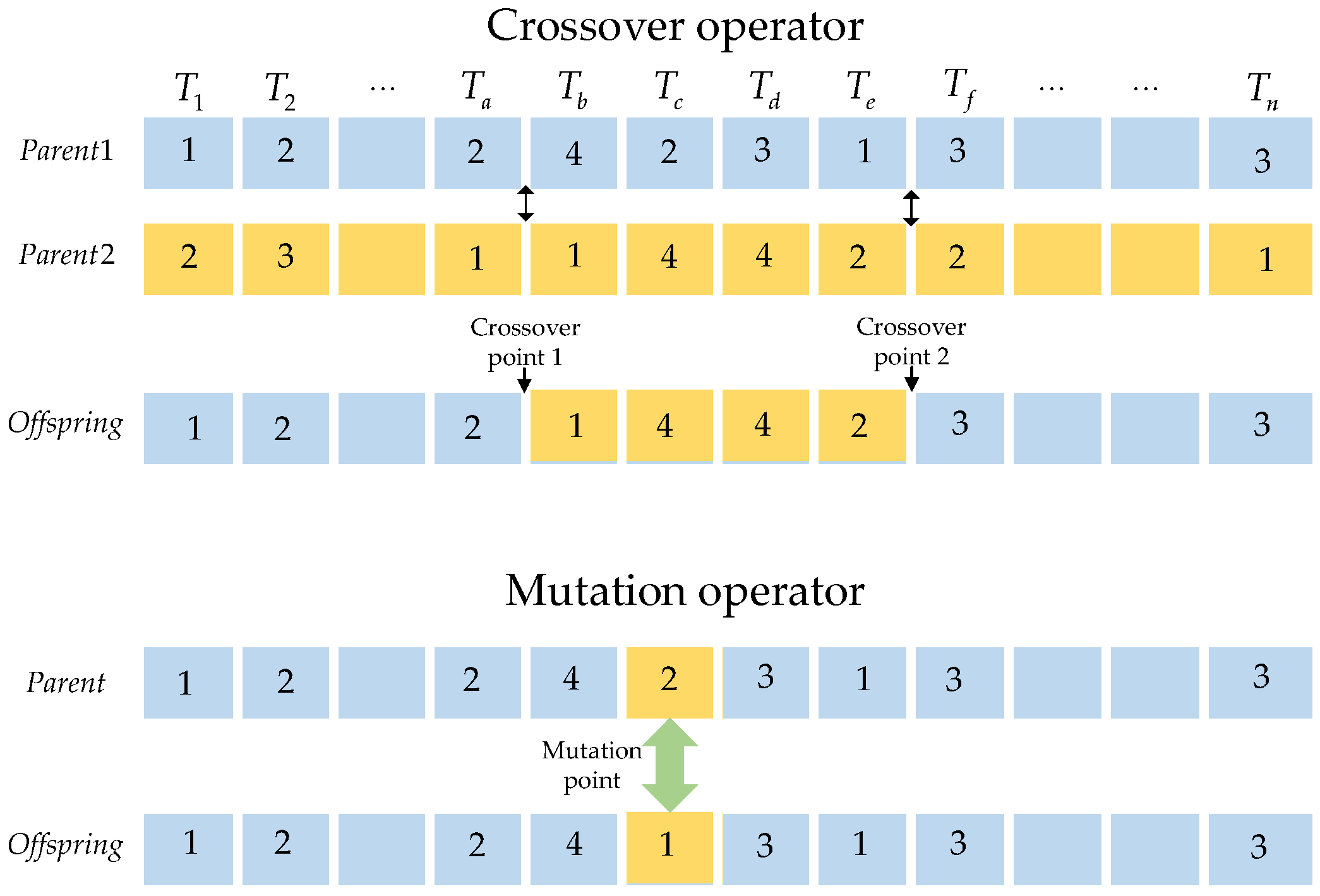
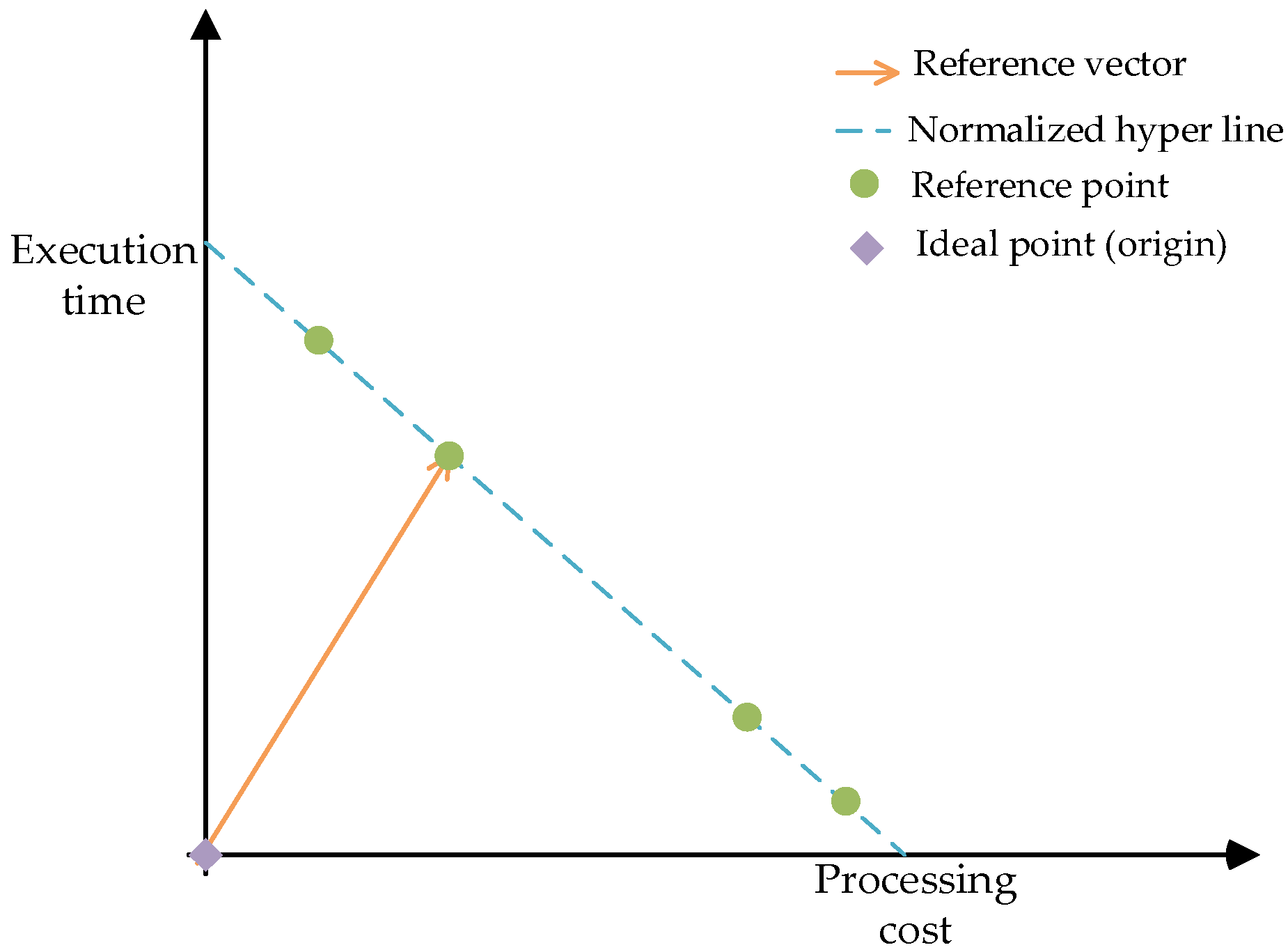
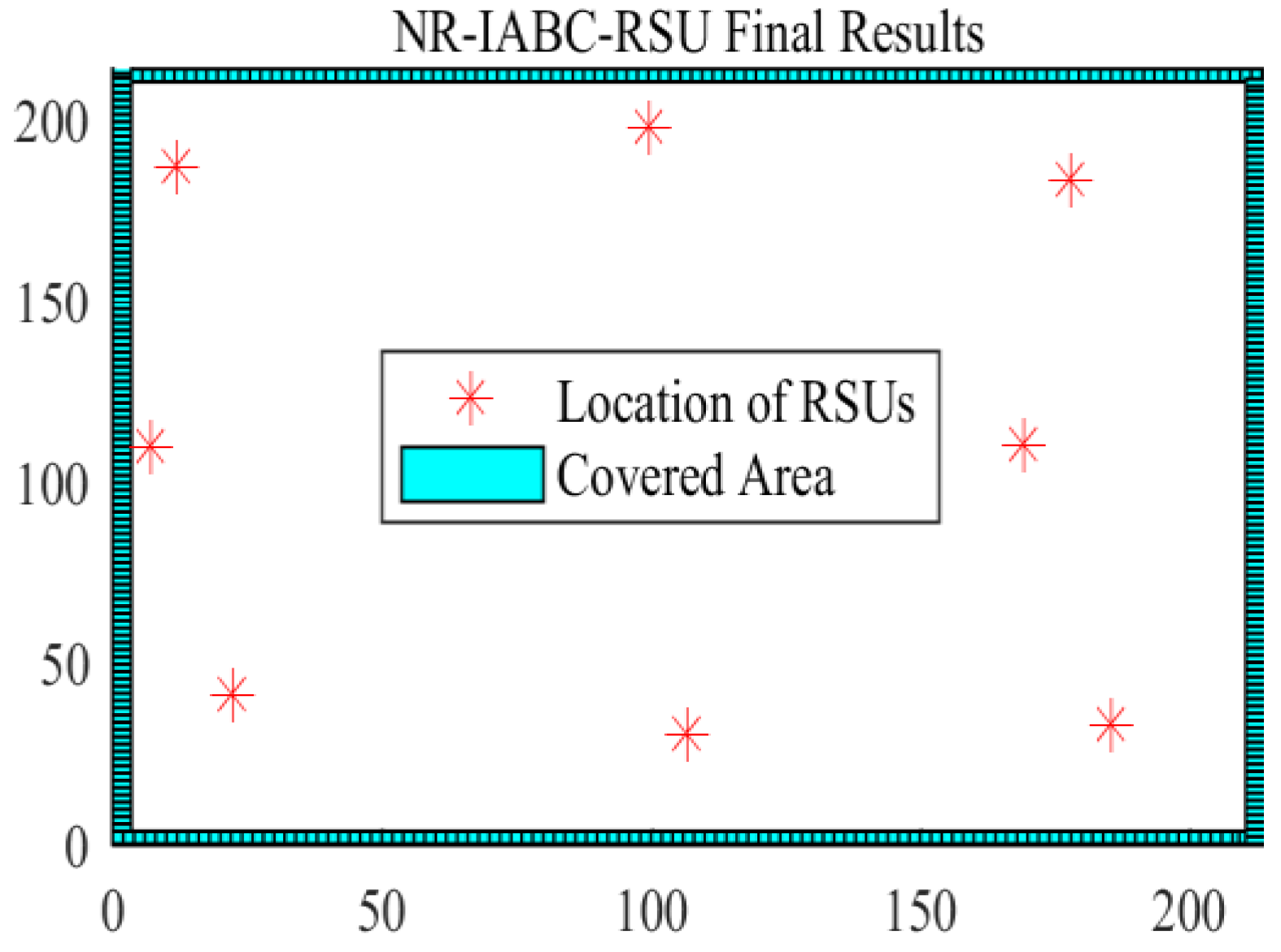
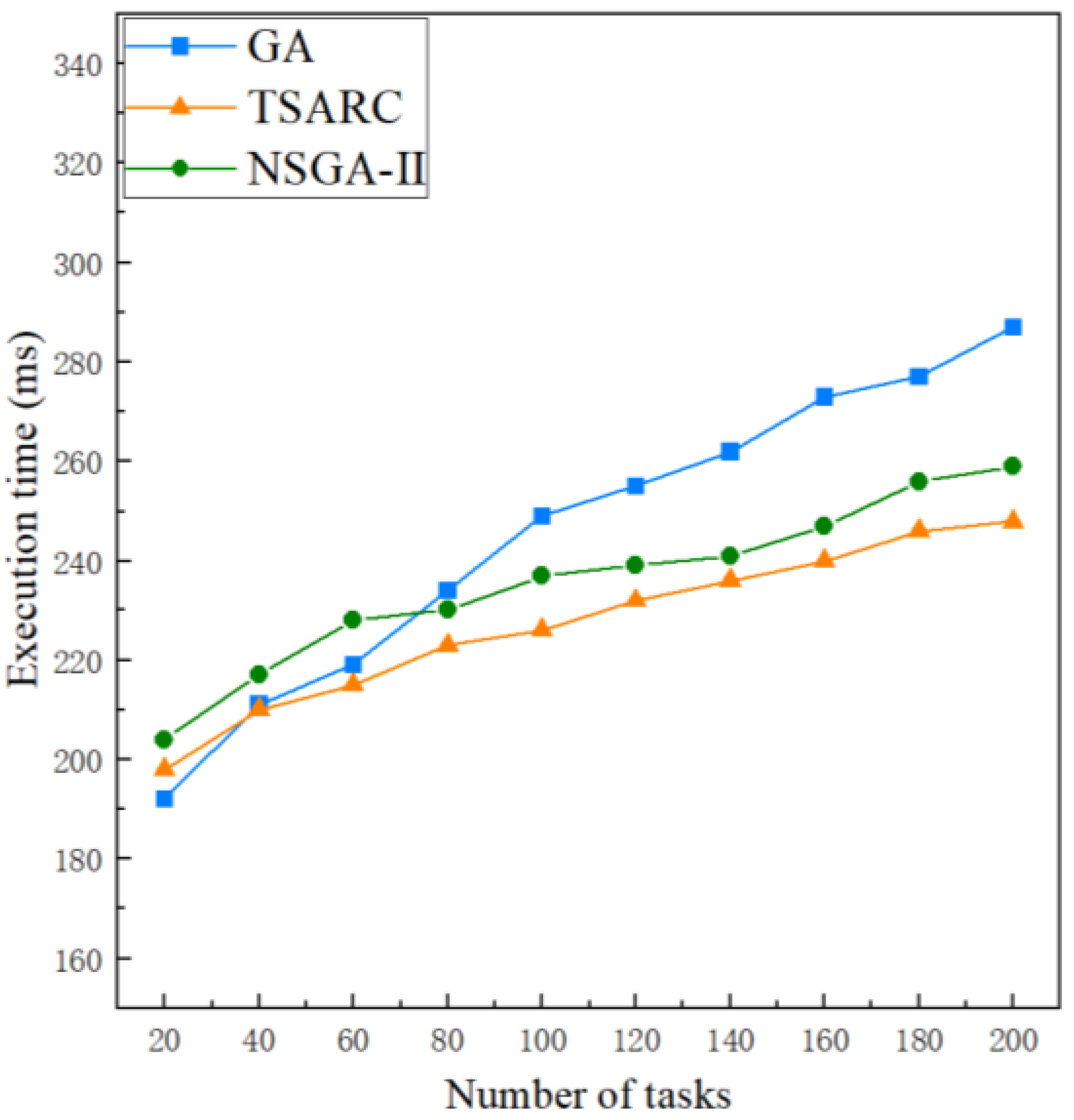
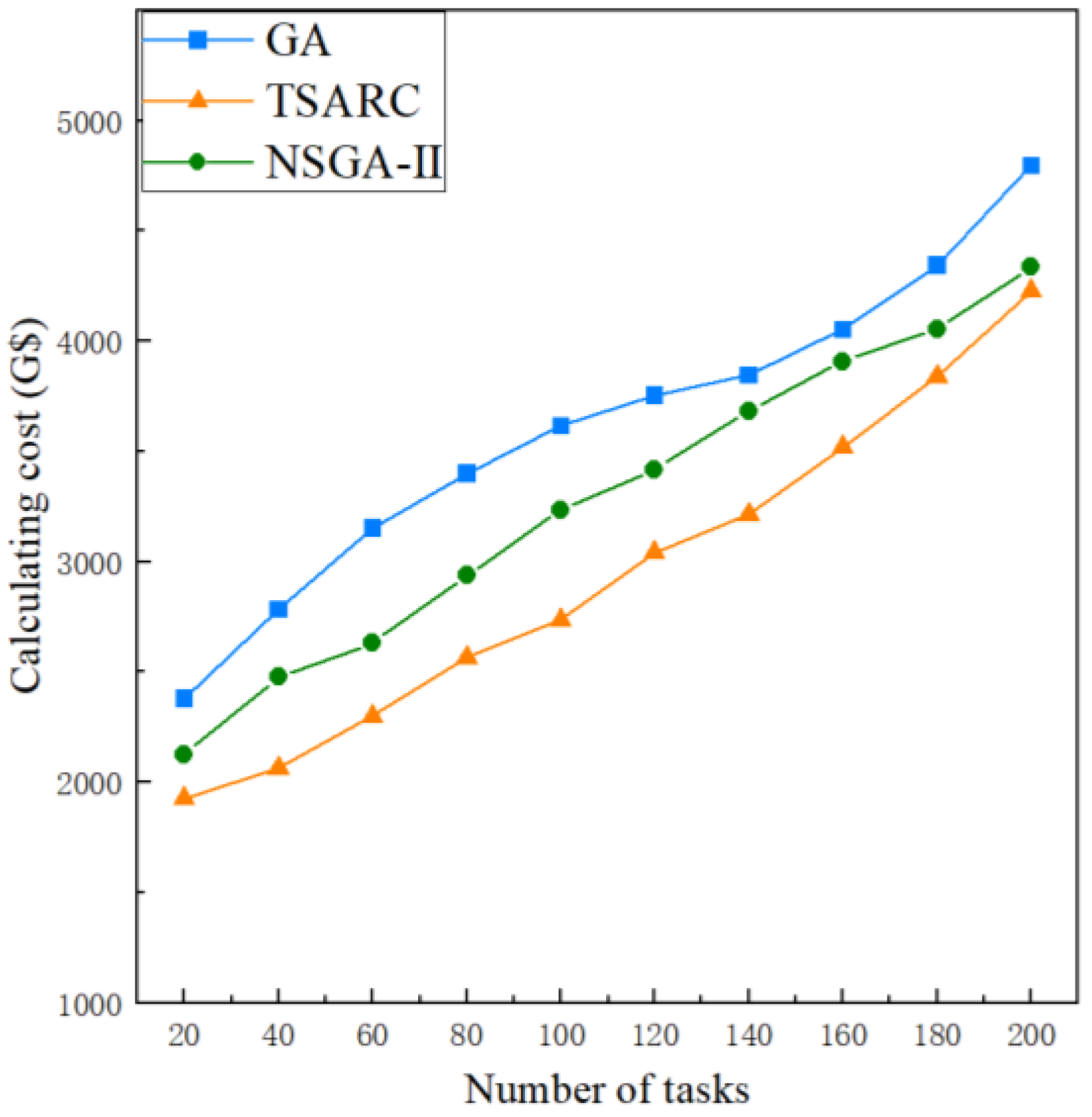
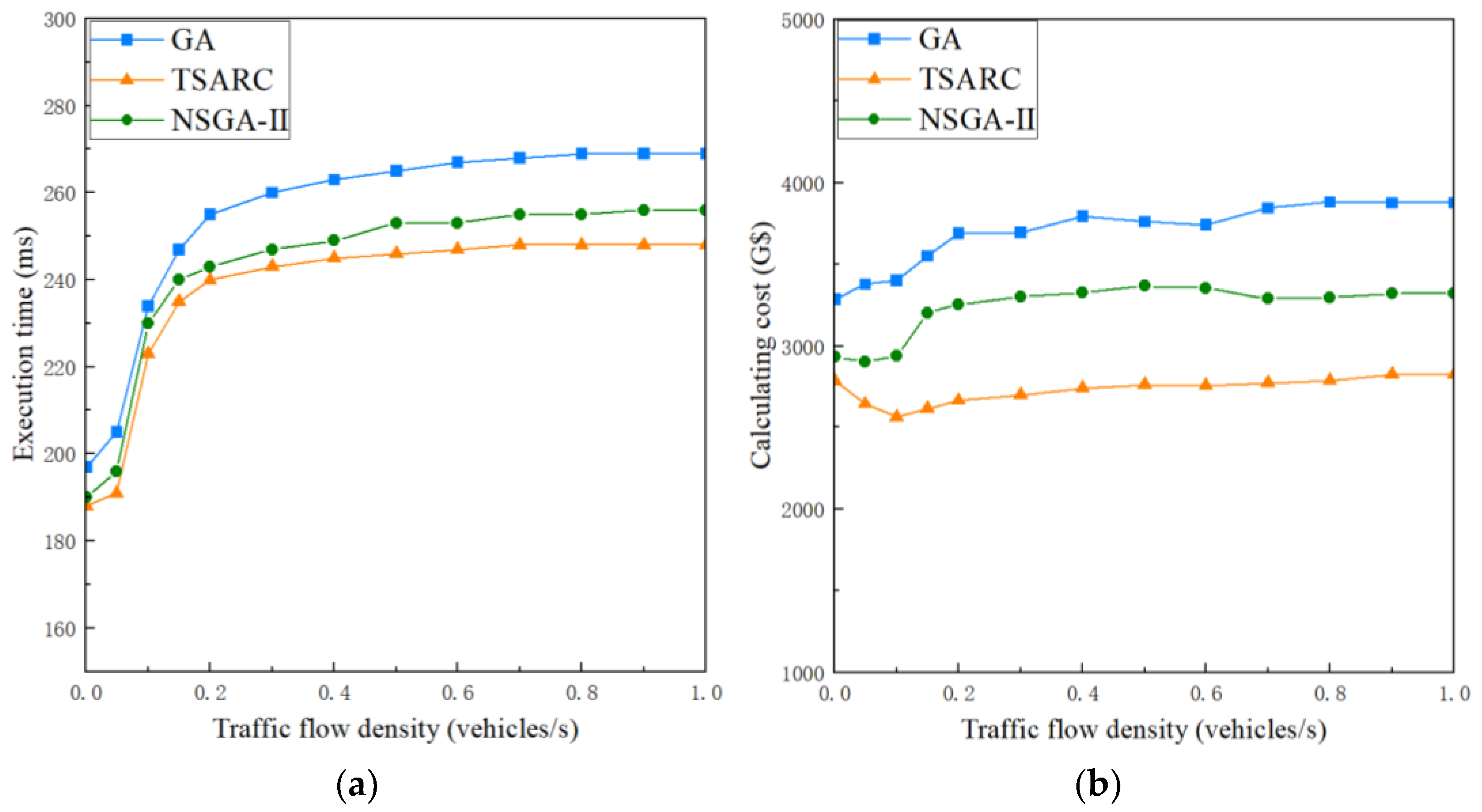

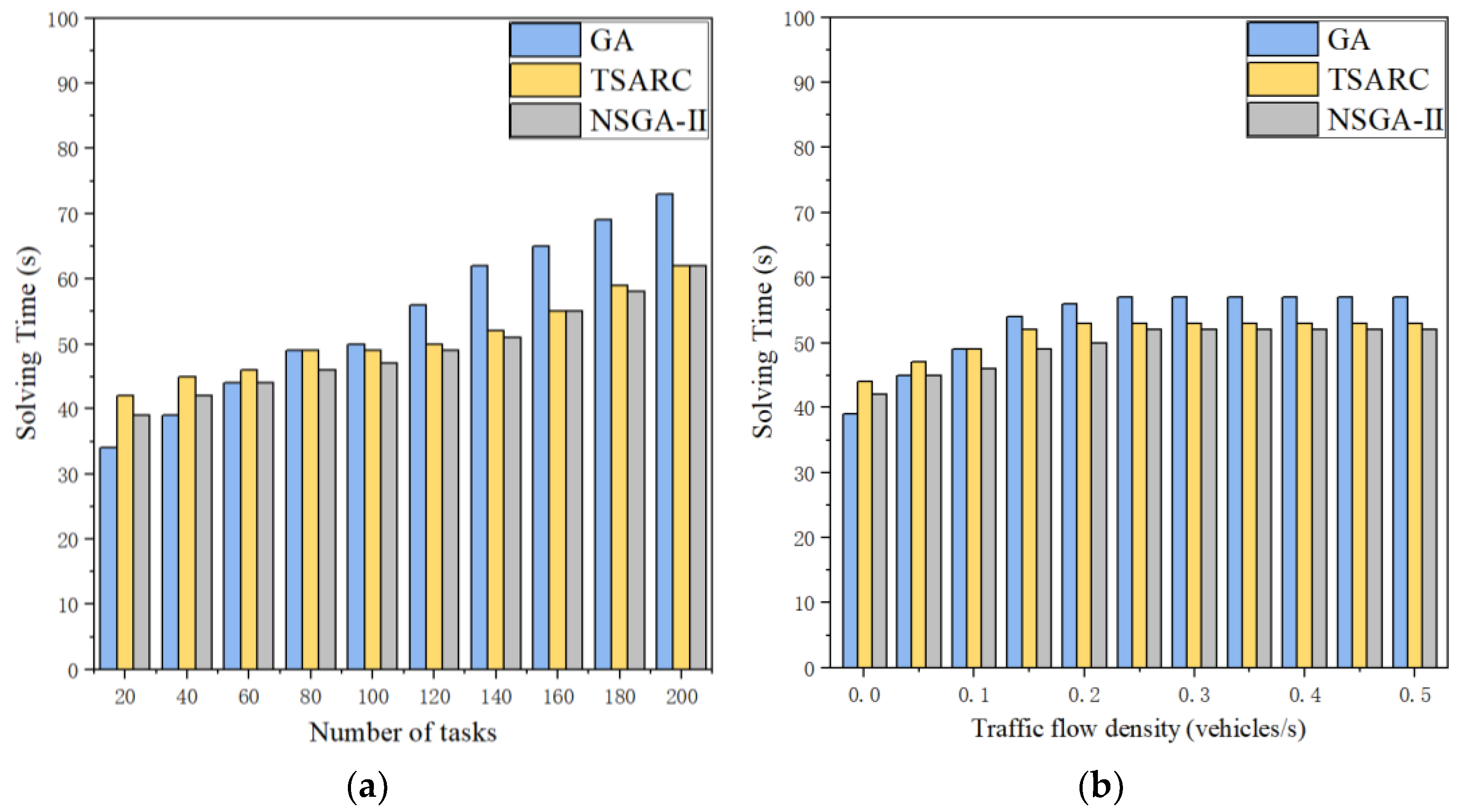
| Parameters | Description |
|---|---|
| Road width | |
| γ | Truck arrival rate |
| λ | The wavelength of V2X signal |
| The radius of the first Fresnel ellipsoid | |
| The occlusion length of traffic flow | |
| Reflection coefficient | |
| Kirchhoff parameter | |
| f | The frequency of V2X signal |
| τ | Minimum received sensitivity threshold |
| The transmitting power of the OBU | |
| The received power of the RSU | |
| Distributed inter-frame spacing | |
| The length of the competitive timeslot | |
| The uploading duration of the signal packet | |
| The rate of the wireless channel | |
| The size of the signal packet | |
| e | The quantity of RSUs |
| u | The quantity of OBUs |
| n | The quantity of tasks |
| Variables | Description |
| α | A continuous variable. The included angle between AB and A’B |
| θ | A continuous variable. The elevation angle between OBU and RSU |
| A continuous variable. Diffraction attenuation | |
| A continuous variable. The attenuation in free-space path loss condition | |
| A continuous variable. The attenuation in NLOS/LOS condition | |
| A continuous variable. The probability of NLOS/LOS condition | |
| A discrete binary variable. Whether the V2X signal is transmitted normally in NLOS/LOS condition | |
| A continuous variable. The packet success rate at position s | |
| A continuous variable. The packet loss rate at position s | |
| A continuous variable. Competition delay | |
| A continuous variable. Processing time | |
| A continuous variable. The execution time of the ith RSU | |
| A continuous variable. Total execution time | |
| A continuous variable. Processing cost | |
| A continuous variable. Memory usage cost | |
| A continuous variable. Bandwidth usage cost | |
| A continuous variable. The calculating cost of the kth task by the ith RSU | |
| A continuous variable. Total calculating cost |
| Step | Operation |
|---|---|
| 1 | OBUs send requests to the nearest RSUs to connect to them |
| 2 | These requests are forwarded to the MEC broker for analysis |
| 3 | Each workflow application is decomposed into a group of tasks |
| 4 | The number of instructions and the required resource usage are estimated |
| 5 | The MEC broker runs the task scheduling algorithm |
| 6 | The tasks are assigned to the corresponding RSUs |
| 7 | Each RSU handles its assigned tasks |
| 8 | All task processing results are fed back to the MEC broker |
| 9 | The MEC broker merges all of the results when all tasks are completed |
| 10 | The response is sent to the OBUs through RSUs to connect with them |
| Parameters | Values |
|---|---|
| 3.5 (m) | |
| λ | 0.05 (m) |
| f | 5.9 (GHz) |
| τ | −80 (dBm) |
| L | 200 (m) |
| MaxIt | 200 |
| nPop | 100 |
| K | 126 |
| ε | 15 |
| ϕ | 10% |
| Number | 8 |
| Rate of the CPU | [500, 1000] (MIPS) |
| Required memory | [50, 200] (MB) |
| Size of the input file | [10, 100] (MB) |
| Size of the output file | [10, 100] (MB) |
| Usage cost of the CPU | [0.1, 0.4] (G$/s) |
| Cost of the memory usage | [0.01, 0.03] (G$/MB) |
| Cost of the bandwidth usage | [0.01, 0.02] (G$/MB) |
| Number of instructions | (instructions) |
Disclaimer/Publisher’s Note: The statements, opinions and data contained in all publications are solely those of the individual author(s) and contributor(s) and not of MDPI and/or the editor(s). MDPI and/or the editor(s) disclaim responsibility for any injury to people or property resulting from any ideas, methods, instructions or products referred to in the content. |
© 2023 by the authors. Licensee MDPI, Basel, Switzerland. This article is an open access article distributed under the terms and conditions of the Creative Commons Attribution (CC BY) license (https://creativecommons.org/licenses/by/4.0/).
Share and Cite
Feng, M.; Yao, H.; Li, J. A Task Scheduling Optimization Method for Vehicles Serving as Obstacles in Mobile Edge Computing Based IoV Systems. Entropy 2023, 25, 139. https://doi.org/10.3390/e25010139
Feng M, Yao H, Li J. A Task Scheduling Optimization Method for Vehicles Serving as Obstacles in Mobile Edge Computing Based IoV Systems. Entropy. 2023; 25(1):139. https://doi.org/10.3390/e25010139
Chicago/Turabian StyleFeng, Mingwei, Haiqing Yao, and Jie Li. 2023. "A Task Scheduling Optimization Method for Vehicles Serving as Obstacles in Mobile Edge Computing Based IoV Systems" Entropy 25, no. 1: 139. https://doi.org/10.3390/e25010139
APA StyleFeng, M., Yao, H., & Li, J. (2023). A Task Scheduling Optimization Method for Vehicles Serving as Obstacles in Mobile Edge Computing Based IoV Systems. Entropy, 25(1), 139. https://doi.org/10.3390/e25010139






